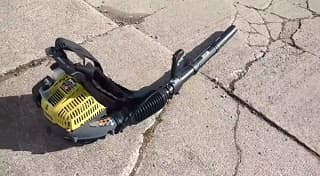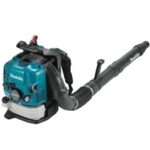As an Amazon Associate, this site earns commissions from qualifying purchases. For more information click here.
Leaf blowers have come a long way in terms of reliability, but we still run into problems every now and then. For example, you may have fueled the blower but it refuses to run. Is the blower totally damaged? Before you take it to a service center, let us take a look at the reasons why this is happening and how to fix it.
If your leaf blower has a spark plug and fuel but refuses to run, the spark plug is probably broken and needs to be replaced. If that does not work, the engine could be flooded or the compression is less than 90 PSI.
Leaking Fuel Line
The gas line can leak due to wear and tear or other reasons. If that happens it can affect the entire engine. The leaf blower may start and stall or not run at all.
If there is fuel all over the gas lines, you probably have a flooded engine. If a gas blower does not start, the instinct is to add more fuel. But if the engine is flooded that will only exacerbate the problem.
What you need to do is open the choke, go full throttle and let the engine expel the excess fuel. You might have to remove the fuel line from the carburetor to access the choke.
You should also check the fuel line. If it is damaged it can cause a lot of issues. The best solution is to buy and install a new fuel line.
Faulty Spark Plug
A faulty spark plug causes all kinds of engine trouble. If there is a fuel leak, it will reach the spark plug, so each time you prime it the spark plug gets covered with fuel.
The solution is to find the fuel leak and stop it. As long as the leak is there, cleaning the spark plug is pointless. If there is no leak, it is the spark plug itself that is broken. Replace it right away and try the blower again. This is easy to do with the Craftsman CMXGAAMR5 because of its efficient design.
Check your manual for details on where to find the spark plug, it will vary from blower to blower. A damaged or dirty spark plug is easy to spot. The best option is to just buy a new one so you can check right away if it is the cause of the problem.
To replace the spark plug, do the following.
- Turn the leaf blower off. Wait for the engine to cool down. Remove the engine cover.
- Locate the spark plug wire. Twist it until it comes off.
- Get a wrench and use it to loosen the plug. If there is carbon on the plug or it is damaged, replace it. Check with the manufacturer so you can find the right park plug for replacement. Or just take the damaged plug to a hardware store and they should be able to find the right one.
- Once you have installed the new spark plug, reconnect the wire and try the leaf blower again.
Flooded Engine
If the spark plug gets when you prime, the engine is flooded. There are many reasons why leaf blower engines get flooded, but you should start by checking the fuel line connectors.
You should also inspect the fuel filter to see if it is blocked by residue. This can happen when you use the blower to clear leaves on gravel.
You can also flood the engine if there is too much fuel being applied incorrectly. Priming itself does not cause flooding as it draws air out of the gas line.
There are many ways to fix this. The first is to turn off all the other systems and pull the starter rope. Keep pulling 6-8 times and it could un-flood the engine. If that does not work, try starting the blower but do not prime it. Turn the blower on and also switch the throttle and choke to on.
What you are doing here is remove excess fuel from the engine. Keep pulling the starter rope until you the engine pops. When that happens put the choke back into the off position. Make sure to set the choke to off after one pop. If you let the engine pop twice it will flood again. Pull the cord 1-3 times and the blower should run fine.
Old Fuel
Leaf blowers, whether it is 2 stroke or 4 stroke, will not work on old fuel. Leaf blower fuel has to be replaced every 30 days. Fuel turns into a sticky, thick liquid when stored for long periods. If you are not going to use the blower for a long time, empty the tank.
Do not leave gas in the tank when you store the blower during winter. It will freeze and could permanently damage the engine. You can put anti-freeze but it is better to just remove the fuel.
Use only the fuel the manufacturer recommends. Also make certain you get the mix ratio right for a 2-stroke engine. A 4-stroke blower has separate reservoirs for gas and oil so do not mix the two.

Broken Recoil Starter
The recoil starter is made up of the cord or rope and a pulley. This design is used to start gas leaf blowers, chainsaws and other power tools. If something goes wrong with the mechanism, the blower will not run no matter how full the fuel tank is.
Problems with the recoil starter may stem from wear and tear. It should be easy to notice if something is wrong with the cord. When you pull it the rope dos not feel right or the pulley does not respond. In this case the best recourse is to take the blower to a service center and have the recoil starter examined. This is a good example why buying a solidly made leaf blower s important. One of our favorites is the Poulan Pro PR48BT because it is dependable.
Of course the problem could be as simple as a tangled cord. In that case you can fix it easily.
- Turn the leaf blower off.
- Remove the spark plug.
- Remove the cord from the handle and assembly.
- Untangle the cord or install a new one.
- Wind the cord, pass it into the recoil starter casing and connect it to the pull handle. Put everything back together and the blower should run fine.
Other Fixes for Leaf Blowers That Won’t Start
If the troubleshooting tips given above do not work, try the following. If you have ever used a hedge trimmer or other power tools before, there are many places to start looking for solutions.
Damaged or dirty carburetor. If the carburetor is damaged, you have to replace it. If you only see dirt and the unit itself is not broken, cleaning may help.
Low PSI compression. A leaf blower should have 90-100 PSI, and larger engines require 150 PSI. Anything less than 90 and the blower may not run. Even if you can get the engine to start, it will probably stall or perform poorly. Your owner’s manual has information on the ideal PSI compression level.
Wear and tear. If your leaf blower is several years old and has seen many hours of use, its engine will eventually wear down. You can replace the fuel lines and spark plugs, but other parts like the crankshaft, cylinders, valves, filters etc. get worn out.
Regular maintenance and proper usage will prolong the life of a leaf blower. But at some point you will need to buy a replacement.
Clogged muffler. The muffler could be clogged with dirt. It may need cleaning especially if you use the blower in a dusty environment.
Dirty air filters. The air filter prevents dirt from clogging the engine and permits only clean air to mix with the fuel. Just like the muffler, air filters will accumulate debris. When it gets clogged, air won’t be able to come in anymore. Worse, the dirt will get through to the engine. When pollutants mix with the fuel, the engine may not start.

I love the outdoors and all the tools for maintaining gardens, yards and lawns. The only thing I am more passionate about is sharing what I know about garden and outdoor equipment.


